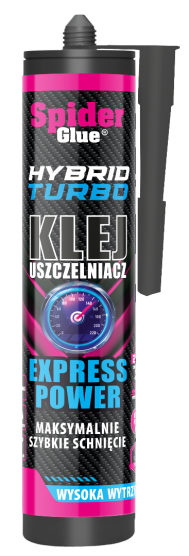Montage Adhesive Spider Glue Turbo
Bonding:
e.g., glass, natural stone, mineral-acrylic composite, quartz conglomerate, concrete, brick, clinker, plaster, many synthetic materials, OSB, MDF, and HDF boards, chipboard and glued boards, plywood, MFP and laminated boards, decorative, raw, and structural wood, iron, aluminum, galvanized sheet metal, steel, stainless steel, and other metals, ceramic tiles, stoneware, and cork.
Fixing:
e.g., MDF skirting boards, polyurethane boards, aluminum, stainless steel, PVC, wood, window sills, stairs, door thresholds, construction boards as well as insulation materials, plasterboards, decorative elements, polystyrene, moldings, frames.
Sealing:
e.g., skirting boards, window frames, stair treads, window sills, and door thresholds. It is also suitable for sealing cracks in walls and ceilings.
For concrete, limestone masonry, mineral plaster, fiber cement, and similar substrates, we recommend using a primer.
Not suitable for PE, PP, PC, PMMA, PTFE, soft plastics, neoprene, and bituminous surfaces. When bonding plastics, always perform an adhesion test first. Adhesion to plastics may vary depending on the type of plastic and its quality.
APPLICATION EXAMPLES / INDUSTRIES
› Strong bonding in vibrating structures;
› Flexible gluing of panels, profiles and most other substrates;
› Sealing floor joints;
› Sealing and gluing in construction;
› Gluing objects, including small decorations, panels and profiles;
› Bonding in industrial applications, including car bodies, caravans, and metal containers;
› Bonding elements of facade and wall sandwich panels;
› Solar and wind power plants;
› Furniture industry;
› Construction of devices and installations;
› Extremely fast setting time;
› Thin and flexible adhesive joint;
› Free from silicone, alkalis, acids and isocyanates;
› Good weather and UV resistance;
› High adhesion to a wide range of building materials, including: brick, concrete, stone, ceramics, tiles, metals, wood, OSB/MDF boards, plasterboards, plastics, insulating materials (polystyrene, polyurethane), and cladding materials (cork, clinker);
› It can be painted/varnished with various types of paints, but due to the wide range of paints and coatings available on the market, it is recommended to perform a compatibility and adhesion test for different configurations of the materials being bonded;
Colour white
Working temperature from 0°C to +40°C
State of matter highly viscous paste
Curing mechanism moisture from the air
Skin formation time about 4 min. (23°C, RH 50%)
Curing speed 2-3 mm/24 h (23°C, RH 50%)
Relative density 1,43 ±0,02 g/m3
Hardened joint
Hardness (Shore A) 65±3
Elongation at break >200%
Module of elasticity 2,2 N/mm2
Thermal resistance (after curing) -40÷+90°C
Tensile strength 2,8 MPa
The surfaces to be bonded should be dust-free and free of any contaminants that could reduce adhesive adhesion. Remove any oil, grease, and loosely bonded paint or varnish coatings, as well as any residue from previous putties or sealants. Degrease the bonded surfaces with mineral spirits or alcohol (isopropanol, ethanol) when bonding glass, tiles, or metals. When bonding plastics, use a detergent as a degreasing agent. Cut the tip and screw on the applicator. Place the cartridge in an application gun used for thick masses (due to the product's viscosity). Apply the product at right angles to the surfaces being bonded. Apply the product on one side in 2-3 mm vertical strips, spaced 10-20 cm apart (depending on the size and weight of the bonded element), to ensure good access of atmospheric moisture to the adhesive joint. Do not apply glue in dots. The glued elements should be joined within 2 minutes of applying the adhesive. To achieve optimal bond strength, the glued elements should be pressed together to achieve a 2 mm thick joint. Adjustments to the position of the glued element are possible up to 4 minutes after applying the adhesive to the bonded surfaces. The adhesive sealant can be removed from tools and glued elements with a dry cloth or one soaked in alcohol or petroleum jelly, but only mechanically after setting.
Logistics
| Capacity | 290 ml |
| Packaging type | cartouch |
| Collective packaging | cardboard 12 pcs. |
| Quantity on a palette | 1560 pcs. |


